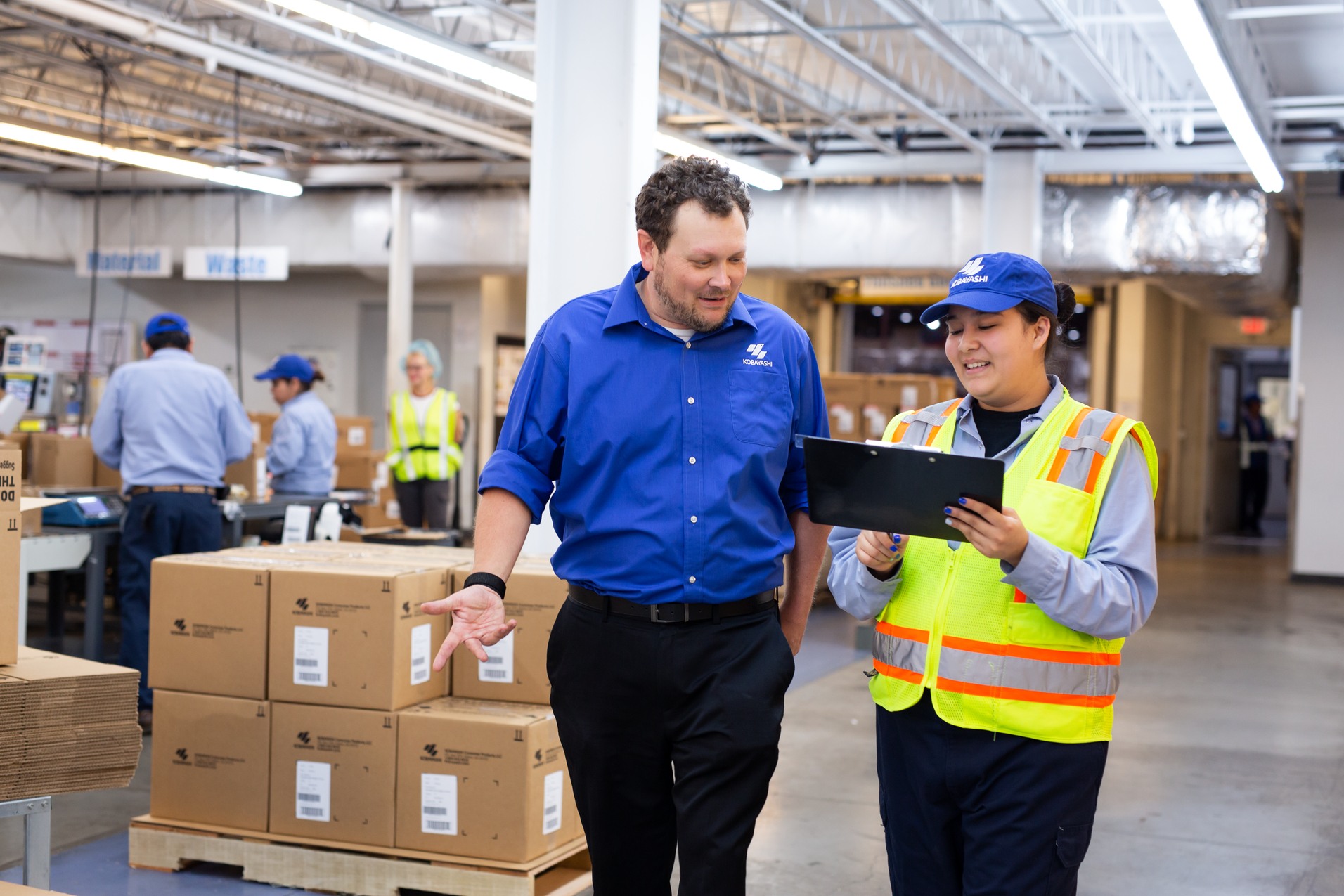Cloud adoption: it’s a marathon, not a sprint.
All long-term projects need good foundations to succeed. If you want to reap the strategic, technical and cost benefits that come with migrating to the cloud, it’s essential to make sure the right cornerstones are in place.
One of those is a workforce that’s engaged with the goals of your project and prepared for the changes that cloud adoption brings with it.
Without the support of your workforce, you risk a vastly decreased return on your investment and limited-to-no realisation of the strategic advantages of switching to the cloud.
So, what role does your workforce play in a successful move to the cloud, and how can you get them onside? Are the benefits of cloud technology worth the effort? We explore more below.
Here’s what we cover:
Why should manufacturers turn to the cloud?
What role does your workforce play in cloud adoption?
6 tips to prepare your workforce for a move to the cloud
Final thoughts on cloud adoption
Why should manufacturers turn to the cloud?
As well as technical know-how, cloud adoption takes a significant amount of advance planning and people management to get right. What does all that effort get you in the long term?
If you’ve not already moved to the cloud, you might be experiencing the following as a manufacturer:
- Reduced visibility into key operations due to siloed data and a lack of real-time reporting functionality.
- Difficulty adapting to remote or hybrid working patterns brought on by the pandemic, many of which are set to stay due to employee demand.
- Error-prone manual processes that are a major time drain and reduce productivity in important areas such as financial forecasting and equipment maintenance.
- Difficulty recovering in the event of data loss or cyber attacks.
Migrating to the cloud is the single most effective way to address these issues because:
- It creates a single source of truth for all your data, removes silos and enables highly accurate artificial intelligence (AI)-driven reports.in real time.
- Your employees can access cloud applications wherever they are (via mobile phone, tablet or laptop; they’re no longer restricted to just using a desktop computer) so long as they have an internet connection. This means it’s easier for remote employees to work productively and feel like part of the team.
- Cloud migration, with the help of AI and machine learning technology, helps you automate previously manual processes. This increases efficiency by completing them faster and reducing human error.
- Backing your data up off-site makes it easier to get up and running in the event of an outage. In addition, third-party data centres employ top-of-the-range IT and physical security experts, which you might not be able to do in-house.
In addition, cloud adoption has a huge impact on:
- Forecasting: AI-enabled cloud technology crunches data in a way that was previously impossible. This transforms the accuracy of your forecasts to create a truly data-driven approach to decision making.
- Reduced IT costs: It’s cheaper to scale cloud applications, and you don’t have to buy, maintain and replace your own servers and associated hardware.
- Reduced manufacturing costs: Predictive maintenance reduces downtime and large-scale equipment expenditure by flagging issues in advance.
What role does your workforce play in cloud adoption?
Ultimately, the reaction of your workforce to new cloud software and processes will make or break the success of your cloud project.
Employee buy-in isn’t optional when you’re migrating to the cloud.
From the beginning, an enthusiastic workforce will help you identify issues with current processes that you could solve using the cloud.
And that’s an on-the-ground perspective you won’t necessarily get from senior management.
They will also be instrumental in helping test the software throughout the implementation and launch period.
Your wider workforce will be best placed to highlight any pain points in your new software and make recommendations on how to remove them.
On the other hand, if you fail to engage your wider workforce with your cloud journey, you risk a poor return on investment, indifference to new software and the creation of inefficient workarounds as a result.
These often create silos of data that you’re spending significant effort trying to avoid by implementing a cloud solution.
In other words, you’re back to square one.
6 tips to prepare your workforce for a move to the cloud
The good news is that preparing your workforce for a move to the cloud doesn’t require anything that’s particularly complex to carry out.
With enthusiasm, openness and a good amount of forward planning, you can prepare your successfully workforce for cloud adoption and encourage buy-in from the earliest stages of your project.
The tips below will help you prepare your workforce for big changes, encourage participation and increase buy-in.
1. Ask for volunteers
Do you need stakeholder representatives for choosing new cloud software? Could you use a diverse testing team to go through new processes with a fine tooth comb before go-live?
What about focus groups to help you identify current pain points and how cloud adoption could eliminate them?
Asking for volunteers is a great way to drive engagement with your cloud adoption strategy. It’s also a useful opportunity for employees involved as they get to build bridges across your organisation and expand their professional experience.
And that’s never a bad thing, particularly if there’s a promotion on the cards.
2. Widen access to vendor demos
You can’t invite every employee to help direct your cloud migration journey, but that doesn’t mean they can’t have any involvement whatsoever.
If you’re migrating to cloud software, let anyone who’s interested sit in on your vendor demonstrations and ask questions.
They’ll be able to see the improvements a new system could make first hand, helping you widen buy-in for your cloud project right from the start.
You could also encourage them to email written feedback to a stakeholder representative, so they get a good sense of their demographic’s feelings towards one system over another.
3. Hold regular drop-in Q&A sessions
Your workforce won’t be enthusiastic about your cloud adoption journey if you’re not visibly enthusiastic about it too.
It’s also important to remember that cloud adoption can be disruptive. Your workforce will undoubtedly have questions they want to ask and concerns they want to address.
Drop-in sessions are a great way to demonstrate the positives of cloud migration while addressing these.
Run them somewhere central at a time when lots of people can make it (a lunch break or just after shift change, for example – remember, no one should be above investing in some free food to encourage attendance).
And if your firm has adopted remote and/or hybrid working, why not deliver sessions via videoconferencing tools?
You could even record them so those who can’t attend can watch back later.
4. Expect and encourage feedback
In the long term, cloud adoption will transform how your entire organisation operates.
It’s all too easy to miss things that could severely set your project back. If you dismiss feedback from across the organisation because you feel they lack expertise, you’ll reduce employee buy-in and risk the success of your project.
This is why your ears should be open to feedback from all areas of your business.
Whether it’s your IT team letting you know about a major technical issue or one of your warehouse crew flagging that a particular stock-taking process would have to change to fit your proposed cloud solution’s feature set, take note.
Large-scale projects have failed on less.
5. Arrange training around working patterns
Don’t leave it up to line managers to provide the training they see fit.
This is a recipe for incomplete training, varying levels of competence across your organisation and unhelpful workarounds developing due to gaps in knowledge.
Instead, make sure there are regular, comprehensive training programmes in place for different employee groups.
Ensure they are accessible – run them via videoconferencing as well if your teams are remote or hybrid working – and ensure your employees have the space to prioritise these over other tasks.
You might lose a small amount of immediate productivity, but you’ll be rewarded in the long term.
The long-term efficiency gains you want your cloud adoption strategy to deliver won’t materialise if your workforce aren’t trained in key areas.
6. Consider gamification
Is your workforce targets-driven? Does a little competition go a long way in driving performance for your team?
If so, gamification might be an option worth looking into.
Look into trophies, rewards and recognition for teams with high training completion rates, for example, or a leaderboard for e-learning scores.
It’s not applicable universally and won’t win you buy-in by itself, but for some workplaces it can help things along significantly.
Final thoughts on cloud adoption
Preparing your workforce for cloud adoption will take a good amount of effort. It’s not something that you should expect to happen organically.
The effort you put in will be absolutely crucial to achieving your long-term cloud adoption goals, such as improving your forecasting and reporting activities, process automation, predictive maintenance and remote working.
While preparing your workforce for cloud adoption might cause some short-term disruption (due to time taken off regular work for training, for example) these immediate losses will be more than made up for by the long-term success of your project.
If you plan well, getting involved in the cloud adoption journey also offers major benefits for your employees as they expand their contacts across the organisation, gain new skills and use on-the-ground insights to inform overall strategy.
With the right strategy, cloud adoption is a win-win situation for employees and the organisation as a whole.
The future of manufacturing
Want to grow your manufacturing firm and become more efficient at the same time? Learn how Industry 4.0 can help you achieve your goals.
Download your free guide
The post Cloud adoption: How to prepare your employees for new processes appeared first on Sage Advice United Kingdom.


